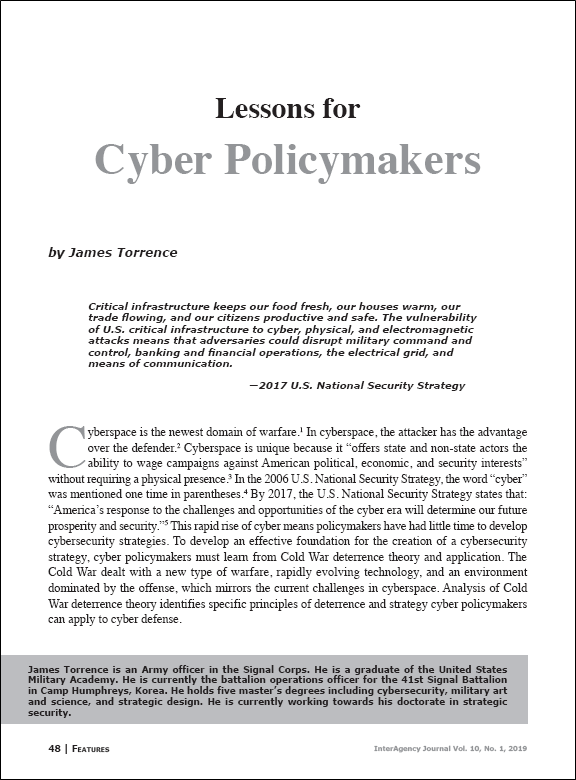Featured Article: Lessons for Cyber Policymakers
Featured article:
Lessons for Cyber Policymakers
by James Torrence
Critical infrastructure keeps our food fresh, our houses warm, our trade flowing, and our citizens productive and safe. The vulnerability of U.S. critical infrastructure to cyber, physical, and electromagnetic attacks means that adversaries could disrupt military command and control, banking and financial operations, the electrical grid, and means of communication.
―2017 U.S. National Security Strategy
Cyberspace is the newest domain of warfare. In cyberspace, the attacker has the advantage over the defender. Cyberspace is unique because it “offers state and non-state actors the ability to wage campaigns against American political, economic, and security interests” without requiring a physical presence. In the 2006 U.S. National Security Strategy, the word “cyber” was mentioned one time in parentheses. By 2017, the U.S. National Security Strategy states that: “America’s response to the challenges and opportunities of the cyber era will determine our future prosperity and security.” This rapid rise of cyber means policymakers have had little time to develop cybersecurity strategies. To develop an effective foundation for the creation of a cybersecurity strategy, cyber policymakers must learn from Cold War deterrence theory and application. The Cold War dealt with a new type of warfare, rapidly evolving technology, and an environment dominated by the offense, which mirrors the current challenges in cyberspace. Analysis of Cold War deterrence theory identifies specific principles of deterrence and strategy cyber policymakers can apply to cyber defense…
Read the full article
Lessons for Cyber Policymakers PDF
Download the complete edition
IAJ 10-1 (2019) pdf
IAJ 10-1 (2019) ePub
James Torrence is an Army officer in the Signal Corps. He is a graduate of the United States Military Academy. He is currently the battalion operations officer for the 41st Signal Battalion in Camp Humphreys, Korea. He holds five master’s degrees including cybersecurity, military art and science, and strategic design. He is currently working towards his doctorate in strategic security.

Posted: March 13, 2019 by Simons Center
READ THE LATEST UPDATES FROM THE SIMONS CENTER
"*" indicates required fields


